3 Basic Transaction Entry
A basic transaction consists of the exchange of store merchandise for a customer's tender. No transactions can be entered into Oracle Retail Xstore Point of Service until you log in at the Register Login screen (see Log In to Oracle Retail Xstore Point of Service). This prevents unauthorized personnel from accessing the register. Logging in also allows the system to record each associate's sales, calculate commissions, and compare sales to employee goals.
Note:
Ensure that the store and register are open, the cash drawer/till has been counted, the associate is clocked in (if required), and the till is attached to the register (if required) before beginning a transaction.
Depending upon your system's configuration, you may be required to clock in before logging in. For more information about the clock-in procedure, refer to Clock In and Clock Out.
Note:
Your store may have a dual screen which displays items that the customer may be interested in purchasing. Depending on your store's policy, you may want to discuss these with the customer during check out.
Your system may have a Self Check-Out (SCO) function whereby the customer scans items and pays by card only.
Log In to Oracle Retail Xstore Point of Service
Use the following steps to log in to Oracle Retail Xstore Point of Service:
-
At the Register Login screen, scan or key your employee ID number, then press Enter to continue.
Figure 3-1 Register Login ID Prompt

Note:
If your system is set up to use a Biometric Fingerprint device, use the device to scan your fingerprint rather than entering your user ID and password. Note: Keyed entry and card scan are also supported here
-
The system prompts for your password. Type your password and press Enter to continue. For security purposes, your password displays as a row of asterisks.
Figure 3-2 Employee Login Password Prompt

Note:
You may be prompted to clock in and select a work code.
Entering Pre-Sale Information
Depending on your store configuration, one or more of the following actions may be required when beginning a sale transaction:
Select Commissioned Associates
If your store tracks the associates' sales for commissions and sales goals, you may be prompted to select a commissioned associate (or associates) to be linked to the items in a sale transaction.
Oracle Retail Xstore Point of Service awards commissions on a per-item basis, either automatically based on the associates selected at the start of a retail transaction, or by prompting for the commissioned associate (or associates) each time an item is added to the transaction.
Note:
If your system is not set up for automatic commissioned associate prompting, you also have the option to link an associate (or associates) to individual items in a sale transaction.
Figure 3-3 List of Commissioned Associates
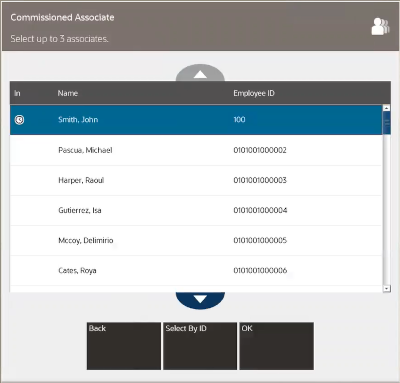
Use one of the following procedures to select commissioned associates for the transaction:
Enter an Associate ID
To select an associate by ID:
-
Click Select By Associate ID.
-
Figure 3-4 Commissioned Associate Prompt

-
Enter the associate ID.
-
Press Enter.
Select Associates from a List
-
Use the up and down arrow keys to highlight an associate.
Note:
The clock icon in the “In" column indicates the Associate has clocked in (see Clock In and Clock Out).
-
Press the Spacebar.
-
Repeat Steps 1 to 2 for each associate to add to the transaction.
Note:
To remove an associate from a transaction, highlight the associate in the list and press the Spacebar.
The system adds the associates to the sale transaction and displays the associates' names on the view port.
Figure 3-5 Associate Name in View Port
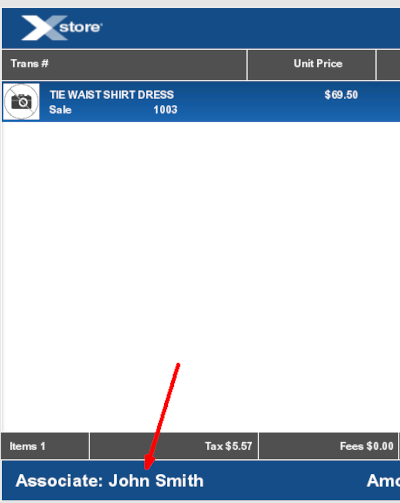
Note:
You also have the option to link an associate (or associates) to individual items in a sale transaction. See Change the Commissioned Associate for more information about associating a commissioned associate with a specific item in a transaction
Associate a Customer with a Transaction
Depending upon your system's configuration, you may be prompted for customer information so that a customer may be assigned to the transaction.
Note:
If a customer is not required for this transaction, you may click Skip to continue with the sale process.
To associate a customer with a transaction, do one of the following:
Search for Customer
Do the following at the Customer Search screen:
Figure 3-6 Customer Search Form
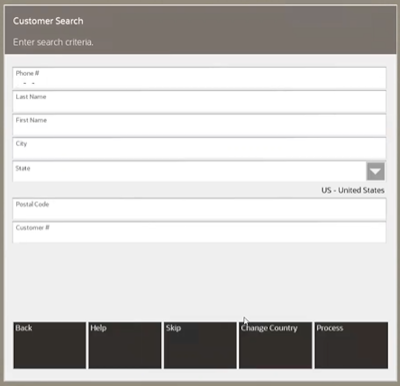
-
Enter the customer search criteria.
-
Click Process.
Note:
The maximum number of returned records is configurable. If your search results exceed that number, you may see a message indicating there are too many results.
You should enter as much information as possible in the Customer Search form. This will limit the number of customer records that are returned. If your search results exceed that number, you may see a message indicating there are too many results.
Oracle Retail Xstore Point of Service displays a list of customers matching the search criteria.
-
Figure 3-7 Customer Search Multiple Results
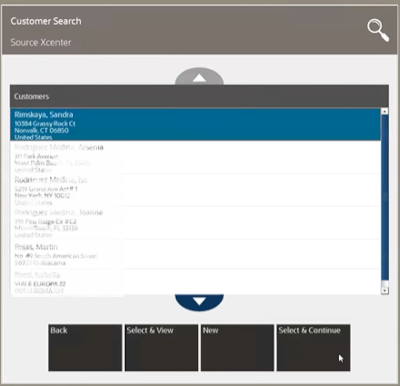
-
Click to select a customer.
-
Click to select a customer and cl
-
-
Do one of the following:
-
Click Select & Continue to assign the customer and continue the transaction.
-
Click Select & View to view the customer record.
-
Click New to create a new customer record.
-
Click Back to return to the Customer Search screen.
-
Tax Exemption
If the customer has a tax exemption on file, you will be prompted whether to apply the exemption. Do one o the following:
-
Click Yes to select a tax exemption:
-
Click a tax exemption in the list.
-
Do one of the following:
-
Click Select & Continue to select the tax exemption and continue the transaction.
-
Click Select & View to select view the details of the tax exemption.
-
-
-
Click No to continue the transaction.
Enter Loyalty Information
If your store has a loyalty program there are several possible scenarios that may occur after assigning a customer to the sale:
Enroll Customer
The system prompts you whether to enroll the customer:
Figure 3-8 Loyalty Registration Prompt

-
Click Not Now to continue the transaction without enrolling the customer.
-
Click Never to continue the transaction without enrolling the customer and never display the enrollment prompt again.
-
To enroll the customer:
-
If necessary, swipe or scan a new loyalty card.
-
Click Process to enroll the customer.
-
Note:
If the customer agrees to join the loyalty program and then decides not to sign up during the transaction, void the loyalty card line item (Void an Item) or cancel the sale (Cancel a Transaction). If you have completed the sale and the customer decides not to enroll in the loyalty program, you will need to post void the sale (Post Void) to disassociate the customer.
Customer Has Multiple Loyalty Cards
If the customer is associated with more than one loyalty account:
-
Click the proper account in the list.
-
Click OK.
Expired Loyalty Card
If the customer's loyalty card has expired:
-
Click Yes to renew the card.
A confirmation prompt displays with the new expiration date.
-
Click No to keep the card expired.
A message prints on the receipt indicating that the loyalty card has expired. The card expiration information also displays on the Customer Maintenance Activity Stream Contact Information Tab.
Entering Items
You can enter items in several ways. To enter items into a transaction:
Figure 3-9 Scan Item Prompt

-
Scan the item.
-
Enter the item ID or UPC code and press Enter.
-
Choose the item from the Quick Pick screen.
-
Use Item Lookup to find an item and add it to the sales transaction.
Oracle Retail Xstore Point of Service looks up item and displays it in the View Port.
After entering an item, other prompts may open.
Barcodes with Properties
This section describes all possible barcodes with properties.
Weight in Barcode
If you scan the barcode below, the system converts the data in the given order and sells the weight of the barcode item.
Example 3-1 Weight in Barcode
2150101020006
(21) Weight prefix, (50101) Item number, (02000) weight in grams = 2,0 kg, (6) Check sum

Note:
If the store has a service or self-service scale, creating barcodes with encoded weight, the system decodes the label and sells the item (coded in the barcode) with the calculated price.
Calculated Price = Item price x Weight from the barcode
Quantity in Barcode
If you scan the barcode below, the system converts the data in the given order and sells the quantity of the barcode item.
Example 3-2 Quantity in Barcode
2570018000036
(25) Quantity prefix, (70018) Item number, (00003) Quantity number, (6) Check sum
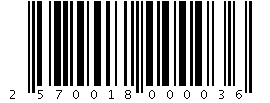
Note:
If the store has a service or self-service scale, creating barcodes where the quantity is coded, the system decodes the label and sells the item (coded in the barcode) with the calculated price.
Calculated Price = Item price x Quantity from the barcode.
Price in Barcode
If you scan the barcode below, the system converts the data in the given order and sells for the price of the barcode item.
Example 3-3 Price in Barcode
2250102003005
(22) Price prefix, (50102) Item number, (00300) price (3,00 $), (5) Check sum

Note:
If the store has a service or self-service scale, creating barcodes where the price is coded, the system decodes the label and sells the item with the price from the barcode.
Press Barcode with Age Verification
If you scan the barcode below, the system converts the data in the given order and sells the press product barcode with the age verification.
Example 3-4 Press Barcode with Age Verification
4343000105396
(43) Prefix with age verification, (4) full VAT, (30001) item number, (0539) price 5,39 $, (6) Check sum

Manual GS1 Entry
If you cannot scan a barcode, use the Manual GS1 Entry menu button to enter the barcode, for example, (01) 02570016000052.
-
Select Find Item. Press the Manual GS1 Entry menu button.
-
You are prompted for the AI. Enter the application identifier (AI) - the number shown in brackets, for example, (01) and press Enter.
Figure 3-10 Manual GS1 Entry - AI

-
You are prompted for the value. Enter the digits after the AI - number in brackets, for example, 02570016000052 and press Enter.
Figure 3-11 Manual GS1 Entry - Value

-
The system shows the following prompt.
Figure 3-12 Manual GS1 Input

-
Repeat the process until you have entered the entire barcode. Press Finish to complete he Manual GS1 Entry. The item is shown on the Sales Display Panel. Complete the transaction as usual.
Note:
To cancel the Manual GS1 Entry, press Back.
RFID
To support RFID (radio-frequency) scanning, Xstore POS can be integrated to the Motorola Zebra DS9808-R Scanner. This scanner scans both the product ID and RFID Tag Reference Number simultaneously.
Scan the RFID tag on the item.
Xstore Classic reads the RFID Electronic Product Code (EPC) tag whilst the product barcode provides the product ID, and the RFID tag extracts the unique reference number of the product.
If the scanner is not working, manually enter the product ID.
Style
A style is an entry in the Item database that has properties such as size, color, and width.
Figure 3-13 Select Dimension
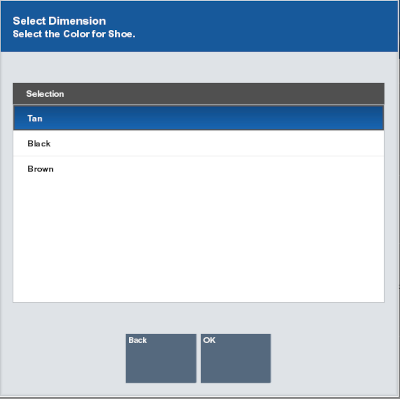
To select a style:
-
Click the style in the list.
-
Click OK.
Attached Item
When an item with an associated attached item is added to a sale, you may be prompted whether or not this additional item should be added to the sale.
Note:
In some cases, the item will be added automatically without prompting the user.
-
Click Yes to add the item.
-
Click No to not include the attached item.
-
If multiple attached items are available:
-
Click the items to be added to the transaction.
-
Click OK.
-
Note:
Attached items are shown with a Link icon next to them.
Kit
When a Kit is added to a sale, the component items are automatically shown in rows below the parent Kit line. Each component item in the Kit shows the quantity included in the Kit, along with the component's description. The component items that make up a Kit cannot be changed using the change item function in Oracle Retail Xstore Point of Service, only the parent Kit can be changed using the change item function.
If all kit components cannot be shown on the View Port due to limited space, the last component row displays an ellipsis (...) to indicate there are additional items in the kit. However, the receipt shows all items that are part of the kit.
Item Restrictions
When certain items are selected, restrictions may apply. These include the following:
Customer Age Verification
Xstore Classic allows you to configure customer age verifications to determine whether a customer meets the age requirements to buy certain items. You can set different age levels for verification (for example, 18 years and 21 years).
An additional age verification is only requested, if an item with a higher restriction is added to the transaction. For example, if the first purchased item has an age limit of 21 and the second item has an age limit of 18, there is only an age verification for the first item, but not for the second one.
To sell an item with an age verification, follow the steps below.
-
Enter an item where an age verification is necessary. Xstore Classic displays a prompt relating to the date of birth of the customer is before a specified date.
Figure 3-14 Customer's Minimum Age Prompt
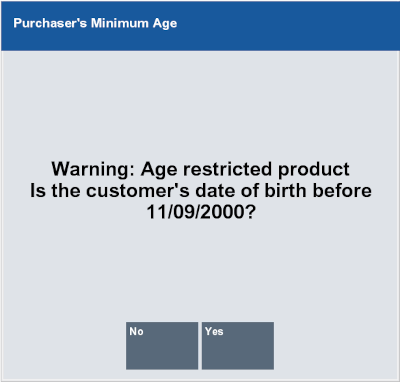
-
Select Yes to confirm the prompt. The item is shown on the Sales Display Panel. For additional items requiring an age verification 18 years, no prompt is displayed.
-
Select No. The item is not added to the Cart. If additional items with an age verification are entered, the prompt is shown again.
-
Cashier Age Restrictions
Xstore Classic allows you to configure cashier age restrictions to determine whether a cashier has the permission to sell certain items. You can activate/deactivate the cashier age restriction per store.
An additional age verification is only requested if an item with a higher restriction is added to the transaction. For example, if the first purchased item has an age limit of 18, there is only an age verification for the first item, but not for the second one.
If the cashier age restriction is activated and there is no date of birth entered for the cashier, the system displays the cashier age restriction prompt.
-
Enter an item with a cashier age restriction. Xstore POS displays a prompt requesting authorization of the transaction.
Figure 3-15 Cashier Age Restricted Item
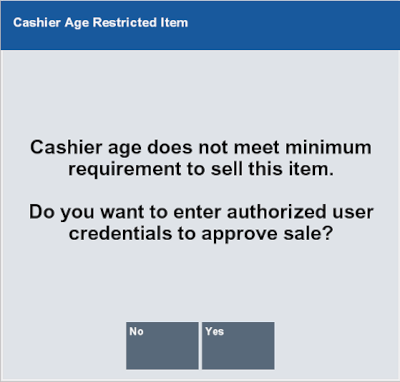
-
Select Yes to authorize the transaction. If No is selected, the item is not added to the sale.
Figure 3-16 Cashier Age Restricted Item Override
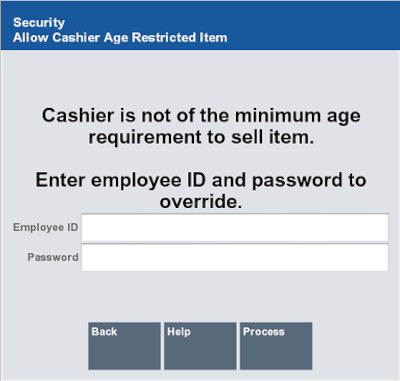
-
Users holding the required security privileges must:
-
Enter your user name.
-
Enter your password.
-
The item is added to the sales transaction and shown on the Sales Display Panel.
Time Restrictions
Xstore Point of Service allows you to configure a time frame in which certain items cannot be sold and/or returned, for example, alcohol. If this function is enabled, items with a restricted time frame can only be sold during authorized hours and days. You can activate/deactivate the time frame restriction by item, department and sub-department.
To sell an item with a time restriction, follow the steps below.
-
Enter an item with a restricted time frame.
-
Xstore Point of Service validates the system time and day against the configured restricted time frame.
-
The system displays the prompt, that the item is currently restricted and not available for sale.
-
Press OK to close the prompt.
Add Non-merchandise Items to a Sale
To add non-merchandise items to a sale transaction (for example, a gift card, alteration, or gift-wrapping service):
-
Click Sell Non-Merch in the Register Sale screen.
The Sell Non-Merch window opens.
Figure 3-17 List of Non-Merchandise Options
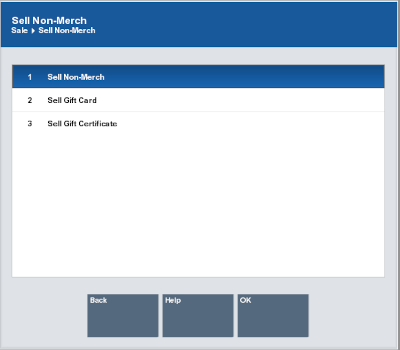
-
Select the type of non-merchandise item to sell:
Figure 3-18 List of Non-Merchandise Items
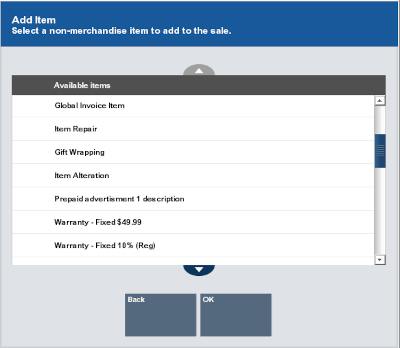
-
Click the type of non-merchandise item.
-
Use the up and down arrows to highlight the correct type of non-merchandise item, then press the Spacebar.
-
Enter the number associated with the type of non-merchandise item.
-
-
Click OK.
-
If necessary, select the item in the list:
-
Click the non-merchandise item.
-
Use the up and down arrows to highlight the correct non-merchandise item, then press the Spacebar.
-
Enter the number associated with the non-merchandise item.
-
-
Click OK.
-
If necessary, enter the amount of the item.
Figure 3-19 Prompt For Price

-
Press Enter.
The item is added to the View Port. Continue the transaction.
Add Wish List Items to a Transaction
Wish list items are purchased through the wish list tab of the Customer Maintenance screen.
-
Start a transaction.
-
If necessary, click Customer Options.
Note:
For extended transactions (for example, layaway, send sale, or special order), go directly to Step 3.
-
Click View Customer.
-
Click the Wish List tab.
Figure 3-20 Customer - Wish List Tab
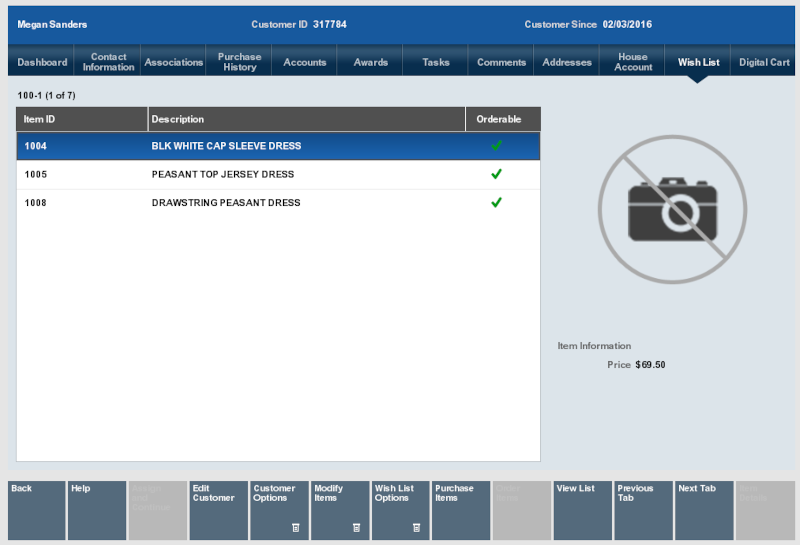
-
Do one of the following:
-
Click Purchase Items to add Wish List items to a sale transaction.
Figure 3-21 Purchase Items

-
Click Order Items to add Wish List items to an order.
-
-
Click the items to include. This will highlight the items.
Note:
Click Select All Items to select all the items in the Wish List.
Figure 3-22 Purchase Items Selected
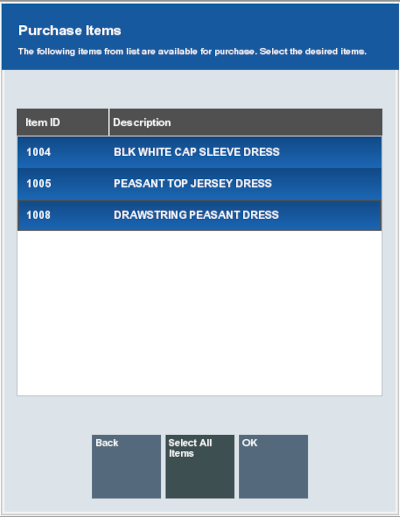
-
If your system has the Scan Items Prior to Adding to Transaction setting configured, the items display in a list to scan from to confirm they are the correct items.
If your system does not have the Scan Items Prior to Adding to Transaction setting configured, no scanning is required. The Wish List Confirmation Prompt opens. Select OK and continue at step 8.
Figure 3-23 Purchase Item Scan Items Prompt
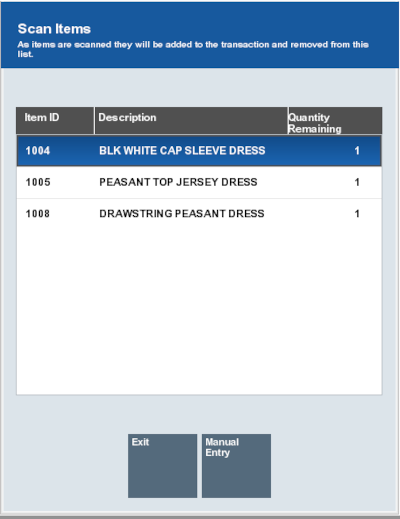
If the item does not scan, select Manual Entry, enter the ID of the item and select Process.
Figure 3-24 Purchase Items Manual Entry
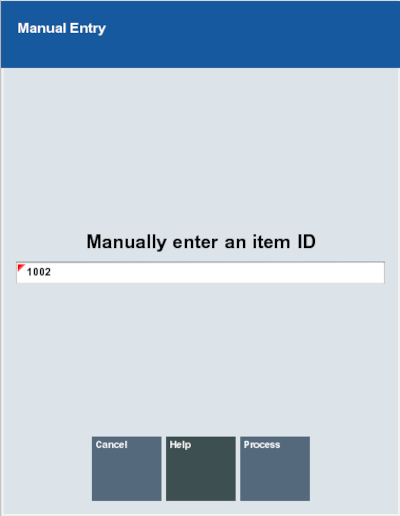
If an item is scanned or entered that does not match any items selected from the Wish List, a warning message is shown, and the item is not added to the transaction. Select OK to continue.
Figure 3-25 Purchase Items Wrong Item Scanned
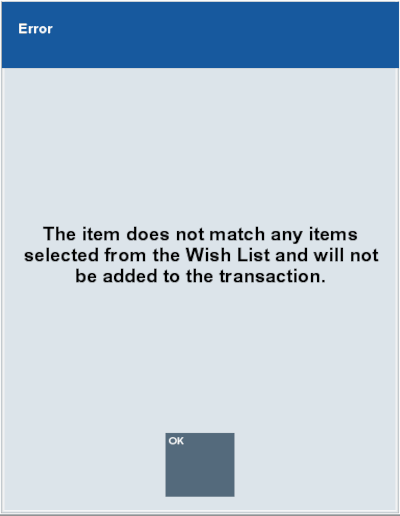
After an item has been scanned or manually entered, it is added to the transaction and removed from the scan items list.
Figure 3-26 Purchase Items After Scan
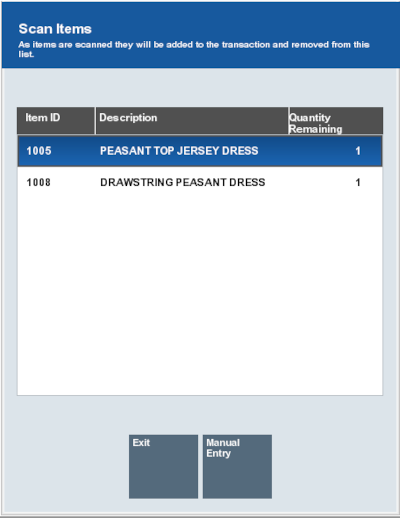
When all required items have been chosen, select Exit.
-
Indicate whether to keep the items in the Wish List:
Figure 3-27 Wish List Confirmation
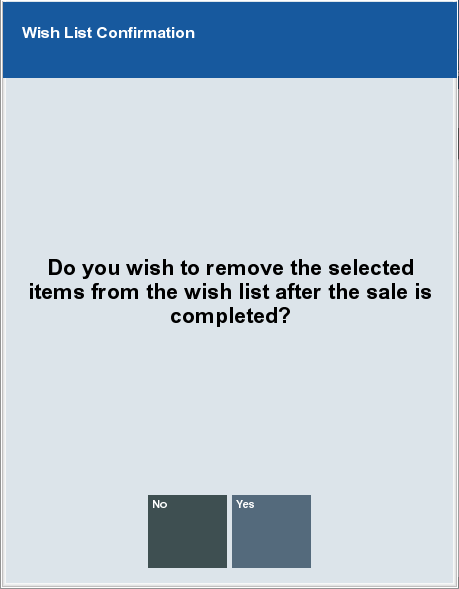
-
Click Yes to add the items to the sale transaction and remove the items from the Wish List.
Note:
If the transaction is post-voided or returned, the wish list items are not reinstated to the Wish List.
-
Click No to add the items to the sale transaction but not remove the items from the Wish List.
-
-
Continue the transaction.
The items appear in the Sale screen View Port with a Wish List icon.
Figure 3-28 Sales Screen Showing Wish List item Added

Add Digital Cart Items to a Transaction
To add Digital Cart items to a transaction for customers who want to purchase items from their Digital Cart:
-
Start a transaction.
-
If necessary, click Customer Options.
-
Click View Customer.
-
Click the Digital Cart tab.
-
Do one of the following:
-
Click Purchase Items to add items to a sale transaction.
Figure 3-29 Purchase Items

-
Click Order Items to add items to an order.
-
-
Click the items to include. This will highlight the items.
Note:
Click Select All Items to select all the items in the Digital Cart.
Figure 3-30 Purchase Items Selected

-
If your system has the Scan Items Prior to Adding to Transaction setting configured, the items display in a list to scan from to confirm they are the correct items.
If your system does not have the Scan Items Prior to Adding to Transaction setting configured, no scanning is required. The Digital Cart Confirmation Prompt opens. Select OK and continue at step 8.
Figure 3-31 Purchase Item Scan Items Prompt

If the item does not scan, select Manual Entry, enter the ID of the item and select Process.
Figure 3-32 Purchase Items Manual Entry

If an item is scanned or entered that does not match any items selected from the Digital Cart, a warning message is shown, and the item is not added to the transaction. Select OK to continue.
After an item has been scanned or manually entered, it is added to the transaction and removed from the scan items list.
Figure 3-33 Purchase Items After Scan

When all required items have been chosen, select Exit.
-
Indicate whether to keep the items in the Digital Cart:
-
Click Yes to add the items to the sale transaction and remove the items from the Digital Cart.
Note:
If the transaction is post-voided or returned, the items are not reinstated to the Digital Cart.
-
Click No to add the items to the sale transaction but not remove the items from the Digital Cart.
-
-
Continue the transaction.
The items appear in the Sale screen View Port with a Digital Cart icon.
Add Item Coupons
To add a coupon to a sale, scan the coupon or enter coupon ID in the Scan Item or UPC prompt and press Enter. The coupon appears in the Offers tab in the Message Window. The tab displays a number in the upper-right corner indicating the number of coupons entered in to the system.
Note:
When a coupon is applied to the transaction, a green check mark appears next to coupon.
Figure 3-34 Offers Tab

Redeem a Rain Check
Rain checks allow customers to purchase out-of-stock items for the same price later.
Note:
Rain checks can only be applied to sale transaction; it cannot be applied to extended transactions (for example, layaways, special orders, or send sales). Once a rain check is redeemed, it cannot be used again.
Depending upon the configuration of your system, you may not be able to redeem rain checks issued by other stores.
To redeem a rain check:
-
Click Register Options in the Sale screen.
-
Click Redeem Rain Check.
-
Scan the rain check or enter the rain check ID.
The Redeem Rain Check prompt opens.
Note:
If the rain check has expired a message displays indicating it has expired and cannot be redeemed.
-
Click Yes to redeem the rain check.
The rain check item appears in the View Port with a rain check icon.
Tendering a Transaction
The tendering process requires that you select or enter two basic items of information:
-
Tender type (for example, cash, check or credit card)
-
Amount paid with that tender type
Depending upon the form of payment and your store's policies, you may have to enter or select additional information, for example:
-
Credit card account number, CID number, and expiration date
-
Customer name
-
Customer address
-
Security approval for large sales or refunds
-
Additional tender types if the first tender type did not pay the total due
-
Additional forms of customer ID (driver's license number, birth date, credit card number, or other ID)
Refer to Processing Tenders for additional information about specific tenders.
Start Tendering
-
Start tendering by doing one of the following:
-
Press Enter in the empty item prompt.
-
Click Add Tenders.
-
-
Tender the transaction. See Processing Tenders
-
If prompted to round up the amount for a charitable donation:
-
Click No to continue with tendering without adding the amount.
-
Click Yes to add the charitable donation to the transaction, then continue with tendering.
-
-
Select the tender by doing one of the following:
Figure 3-35 List of Tender Types

-
Click the tender in the list.
-
Use the up and down arrows to highlight the tender.
A tender amount prompt opens.
-
-
Add the tender amount by doing one of the following:
Figure 3-36 Tender Cash Amount Prompt

-
Enter the amount to apply to the tender.
-
For cash tenders, click a quick cash amount in the Menu Buttons.
Figure 3-37 Quick Cash Buttons
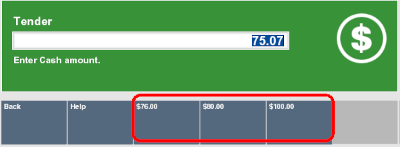
-
-
Press Enter.
-
If you are prompted whether to complete the transaction:
Note:
Your system may automatically print receipts without prompting whether to complete the transaction.
-
Click Y to print receipts.
-
Click N to return to the Sale Tender screen (Step 4).
Oracle Retail Xstore Point of Service prints receipts.
Note:
If you are prompted for e-mail receipt information, see E-mail Receipt Options.
-
-
Depending on the configuration of your system, you may be prompted to scan a cash drawer. Scan the appropriate cash drawer, if necessary.
-
On occasion, upon completing a transaction, a prompt may open asking whether to apply a system update. If you are prompted to apply a system update:
Note:
If you agree to perform the system update, you will not be able to create any new transactions for a certain grace period. Existing transactions can be completed during the grace period.
Once the system is not in a transaction, or if the required period has expired, the update will be automatically applied without asking the user. You cannot use the system during system updates.
-
Click No to be asked again after a period.
-
Click Yes to apply the update.
A confirmation prompt opens:
-
Click Apply to perform the update.
-
Click Cancel to cancel the update and be asked to perform the update after a period.
-
The transaction completes.
-
E-mail Receipt Options
If your store issues e-mail receipts, you may be prompted for more information after the sale is tendered. Any receipts that have been set up for e-mail delivery are generated as PDF documents and sent to the customer's e-mail address as an e-mail attachment. This e-mail receipt process assumes the customer has an active e-mail address and has given permission to receive e-mail from the store.
After tendering the sale:
-
Select the receipt method:
Figure 3-38 Sale Complete Prompt - Email Receipts Enabled
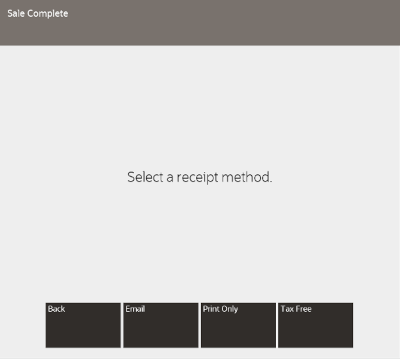
Note:
This choice applies to all receipts. For example, if you choose to e-mail receipts, then all receipts such as Gift and Customer receipts are sent in an e-mail. You cannot print one but e-mail the other.
-
Click Print Only to print the receipts. The receipts print and the transaction completes.
-
Click Email to either e-mail the receipt or e-mail and print the receipts. Continue with the next step.
-
-
Confirm, enter, or change the customer's e-mail address.
Note:
If you make changes to the e-mail address, you may be prompted whether to change the e-mail address for the customer.
Click Yes to change the e-mail address.
Click No to keep the existing e-mail address.
-
Choose an option:
Figure 3-39 Email Address Form
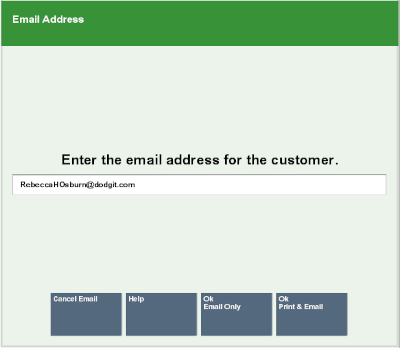
Note:
If the e-mail address is not formatted correctly, a confirmation prompt opens indicating it is not correct. Press Enter then correct the e-mail address.
-
Click OK Email Only to send the receipts in an e-mail.
-
Click OK Print & Email to send the receipts in an e-mail and print them on the receipt printer.
-
Click Cancel Email to cancel the e-mail and return to the Sale Complete prompt.
-
Reprint Receipts and Documents
The reprint options provide a way to recover when there is a printer error or the printer jams. They allow you to reprint a receipt or a rebate offer for the customer.
Figure 3-40 Login Screen - Receipt Reprint Options Menu Button
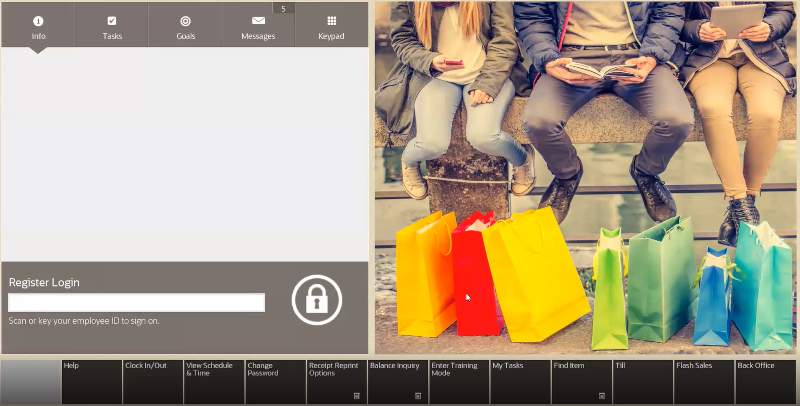
Reprint the Last Receipt
To reprint the last receipt created by the register:
-
Go to the register login screen.
-
Click Receipt Reprint Options.
Figure 3-41 Receipt Reprint Options Menu

-
Click Reprint Last Receipt.
Oracle Retail Xstore Point of Service prompts whether to reprint the last receipt.
-
Click Y to reprint the last receipt.
Note:
The receipt is clearly labeled as a reprinted receipt.
Reprint a Document
To reprint a document (such as a rebate offer):
-
Go to the register login screen.
-
Click Reprint Document. See Figure 3-41.
The Reprint Document Lookup window opens.
Figure 3-42 Reprint Document Lookup Form
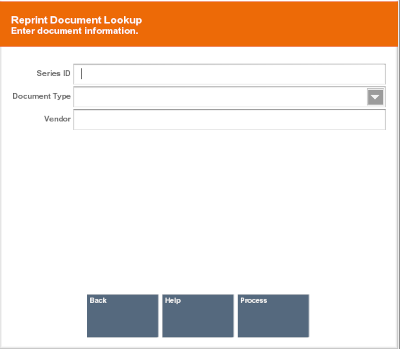
-
Enter the search information for the document:
-
Series ID - Enter the ID for the document series.
-
Document Type - Select the type of document.
-
Vendor - Enter the name of the vendor who produced the document.
-
-
Click Process
Oracle Retail Xstore Point of Service displays a list of documents matching the search criteria.
-
Click the correct document.
-
Press Enter.
Oracle Retail Xstore Point of Service reprints the document on the report printer.
Note:
If the document is not in PDF format, it may also print on the receipt printer.
Print a Rebate Receipt
Rebate receipts may be offered to customers so that they can retain the original receipt for a purchase, and mail in the rebate receipt as proof of purchase.
-
Go to the register login screen.
-
Click Rebate Receipt.
The system prompts for transaction information.
-
Enter the transaction information by doing one of the following:
-
Scan the barcode on the original sale receipt.
-
Enter the barcode information and press Enter.
The rebate receipt prints on the receipt printer.
Note:
The receipt is clearly labeled as a rebate authorization receipt. This receipt cannot be used for merchandise returns.
-
Print a Gift Receipt
During a transaction, items may be selected for a gift receipt before a tender is selected, or between adding tenders. Gift receipts can also be issued immediately after a completed sale transaction, or from the Electronic Journal for eligible items in a transaction. Eligible items include regular sale items, special order pickup items, and layaway pickup items.
Select Gift Certificate Items in a Sale
While a sale transaction is being performed, you may use the following steps to select items to be issued gift certificates:
-
Click Gift Receipt during a sale transaction.
Figure 3-43 Sale Menu - Gift Receipt Button
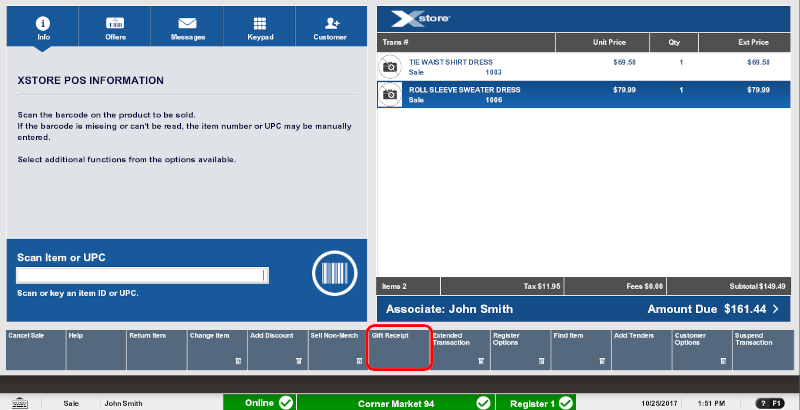
Oracle Retail Xstore Point of Service displays a list of items eligible for gift receipts.
Figure 3-44 List of Items Eligible for a Gift Receipt
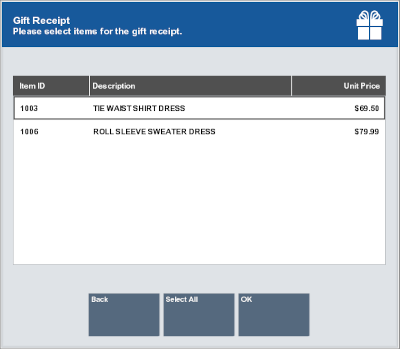
-
Select the gift certificate items by doing one of the following:
-
Click each item.
-
Use the up and down arrows to move to the correct item, then press the Spacebar to highlight it.
Note:
Click Select All to select all items in the list.
-
-
Click OK.
The gift certificate items are labeled in the View Port with a gift icon. Gift certificates will be printed at the end of the transaction.
Figure 3-45 Gift Icon

-
At the end of the transaction, if you are prompted whether to group gift certificate items, see Group Gift Receipt Items.
-
At the end of the transaction, you may be prompted whether to print a gift certificate for each item:
-
Click Yes to print a gift certificate for each item.
-
Click No to print one gift certificate for all items.
-
Group Gift Receipt Items
After tendering the sale, if there are multiple items that have been labeled as requiring a gift receipt, you may be prompted whether to group items on separate gift receipts. For example, you can group 2 items on one receipt, and 3 items on another receipt.
Figure 3-46 Multiple Gift Items - Group Receipts Prompt
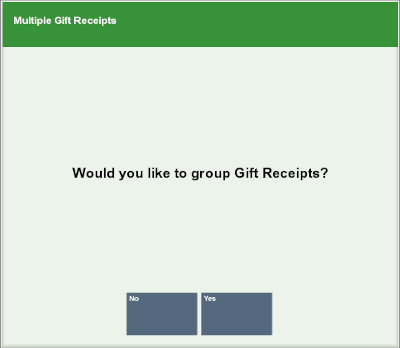
To group items on gift receipts:
-
If you are prompted whether to group gift receipts, select an option:
-
Click Yes to group gift receipt items.
A gift receipt grouping window opens.
-
Click No to continue the transaction without creating gift receipt groups.
Figure 3-47 Items for Gift Receipts

-
-
Select the items to group on one gift receipt by doing one of the following:
-
Click each item.
-
Use the up and down arrows to select an item, then press Spacebar to highlight it.
-
-
Click Add Grouping.
The selected items are grouped into one gift receipt and removed from the list.
-
Click Finish and Print to print the gift receipts and complete the transaction.
Create Gift Receipts After a Sale
To create gift receipts for a previously completed transaction:
-
Click Receipt Reprint Options at the register login screen. See Figure 3-40.
-
Select a receipt reprint option:
-
Click Reissue Gift Receipt reprint only the gift receipts.
-
Click Reprint Last Receipt to reprint gift receipts and the transaction sale receipt.
A Transaction Lookup prompt opens.
Figure 3-48 Transaction Lookup Prompt

-
-
Enter the transaction barcode by doing one of the following:
-
Scan the barcode on the transaction receipt.
-
Enter barcode information and press Enter.
Oracle Retail Xstore Point of Service displays a list of items eligible for a gift receipt.
-
-
Select the gift receipt items using the appropriate procedure:
-
Oracle Retail Xstore Point of Service prints the receipts.